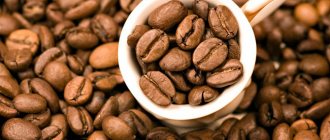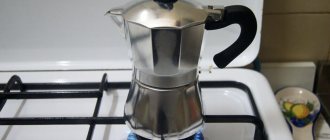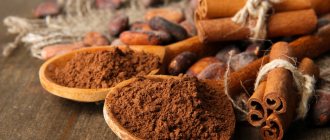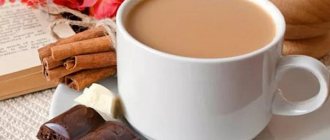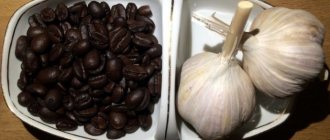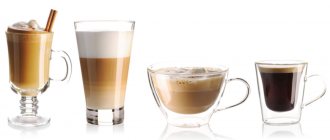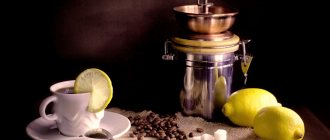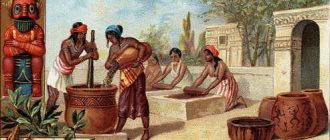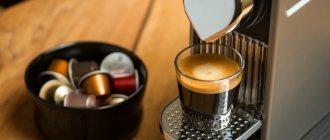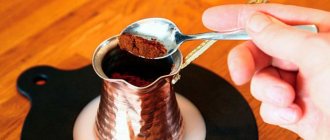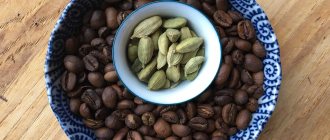If you don't have enough time to prepare an invigorating drink in a Turkish coffee pot or coffee maker, learn how to brew ground coffee in a cup. Most people think that you just need to pour boiling water over the powder and the drink will be ready. But that's not true. To get your favorite drink in a mug in a matter of minutes, you need to know some secrets on how to prepare it. This applies to both the quality of water and the choice of dishes. If you fulfill all the requirements, you will enjoy the aroma and tart taste.
What kind of coffee can you brew?
Most coffee brewing methods are designed to filter the liquid from powder particles. They, unlike tea leaves, do not sink to the bottom immediately, but float in the water throughout the entire volume. If the container is not touched for several minutes, small particles will settle over time, and large fractions will float to the surface. This is the main disadvantage of brewing in a cup.
True connoisseurs recommend making the drink from freshly ground coffee beans. But if you are in the office or just in a hurry, this method will not work. In this case, the finished product in packages comes to the rescue. Moreover, each time after uncorking, it is important to tightly close the container and use a pack of ground powder for two weeks, since over time it loses its aroma. If you rarely drink this drink at home, it is better to purchase a small package.
The best coffee to brew in a mug
High-quality coffee accounts for at least 90 percent of the success of brewing in a cup. You can buy it in grains and grind it at home in a coffee grinder, or buy it in a specialized store, where the grains will be turned into powder before your eyes. It is important to tell the seller that you need coffee to brew in a cup, then he will select the appropriate grind level.
The particles should not be too large, otherwise they will not be able to transfer all their valuable contents to the water, and in addition they will begin to float and will have to be removed from the cup with a spoon. However, grains ground into dust are also a bad option: the powder mixed with liquid will be a suspension of tiny particles that cannot be filtered, and they are in no hurry to settle to the bottom.
You should not create large stocks of ground coffee at home - the aromas tend to evaporate.
When purchasing beans and ground coffee, it is better to give preference to:
- Arabica (robusta, when brewed for a long time in a cup, will make the drink too bitter; we have separate material on their differences);
- premium varieties;
- grains that have been roasted for no more than 1 month.
Ground coffee for preparing in a cup can be purchased at the store in packs, almost ready for use. Some manufacturers make it easier for us to choose by indicating the purpose of their product on the packaging. For example: “Ground coffee “Black Card”. For brewing in a cup."
If we talk about coffee brands that experts prefer when used in this format, then you should pay attention to coffee:
- “Jardine” (we talked about it in more detail here),
- "Live Coffee"
- "Paulig"
- "Jockey".
Manufacturers reveal some of the secrets of their products to highlight their benefits. For example, the “Live Coffee” variety, intended for preparation in a cup, is packaged as quickly as possible after roasting the beans, therefore it retains its aroma and richness of taste throughout the year.
Experts note that when brewed in a cup, single-origin varieties reveal their potential especially effectively:
- Ethiopian Arabica (shades of fruits and berries);
- Arabica from Brazil (slightly sour);
- Arabica South American (notes of chocolate and citrus fruits).
All kinds of coffee with their names and characteristics can be found in this publication.
Selecting the variety and degree of grinding of beans
To brew coffee in a cup, you must use a product with the appropriate labeling, fine or medium grind beans. Most manufacturers indicate “for brewing in a cup” on the packaging. If you use a coarse grind, the powder will not have time to brew.
Interesting! How to brew coffee with milk in Turkish
It is advisable to purchase in specialized stores. Here they will advise you which coffee to choose. If you ask, they can even grind the grains right away for you. Arabica beans are ideal for brewing coffee in a mug. It differs in the following characteristics:
- raw materials from Ethiopia and Yemen are distinguished by fruit and berry shades of prunes and currants;
- the Brazilian type is characterized by a mild taste with sourness;
- the South American product contains notes of chocolate and citrus;
- variety from India and Kenya has a chocolate aftertaste.
To brew a cup of ground coffee, do not use mixtures with Robusta. The coffee will be bitter and too strong. If you take an espresso blend, it should not contain more than 15% robusta.
Methods for brewing coffee in a cup
Ground coffee is measured with a spoon. One teaspoon (without a slide) contains 3 g of finely ground coffee, with a slide - 5-6 g.
There are 5 main brewing methods:
- Brazilian;
- Polish;
- Cuban;
- in the microwave;
- cold (cold brew).
Coffee brewed in a cup can be mixed with milk, syrups, and decorated with cream.
Brazilian way
This is how professional coffee tasters brew coffee. You need coarsely ground coffee (like for a French press).
Place ground coffee in a heated cup and add hot water. Approximate dosage: 8–9 g of ground beans per 100 ml of water. Infusion lasts 4–5 minutes.
During this time, large particles float to the surface, forming a “crust” that prevents the liquid from cooling. Before drinking coffee, you need to use a spoon to remove the “crust” from the cup.
Polish way
Ideal for brewing in the office. To prepare the drink, use fine or medium grind coffee. Approximate dosage: 6–7 g per 100 ml of water.
Recipe:
- Pour coffee into a heated cup.
- If you need sweet coffee, add sugar.
- You can add spices (cinnamon, cardamom) to taste.
- Splash hot water so that it just slightly covers the ground coffee.
- Stir the grounds vigorously with a spoon for 10–15 seconds.
- Pour the rest of the water into the cup and stir.
- Cover the cup with a saucer.
- Leave for 3-4 minutes.
Sugar can be added to the finished drink, but then when stirring with a spoon you will have to stir the grounds, and drinking coffee with suspension is unpleasant. The grounds moistened with water are intensively stirred so that the “blooming” occurs, a foam forms, and when infused, the grains settle to the bottom faster.
To prevent the spices from floating to the surface of the finished drink, they are mixed with dry ground coffee before water is poured into the cup.
Cuban way
It differs from Polish in only a few details:
- prepare a large portion of coffee (about 200 g), preferably in a glass glass;
- the drink must be strong, so for 100 ml of water you need 8–9 g of ground coffee;
- use cane sugar;
- If desired, add 1-2 teaspoons of rum to the finished coffee.
Brewing coffee in the microwave
The method is similar to making Turkish coffee. To obtain a drink of moderate strength, you need 6–7 g of fine or medium grind coffee per 100 ml of water. If possible, it is recommended that after preparing the coffee, pour it into a clean cup.
Recipe:
- Pour coffee into a large heatproof cup.
- Add sugar and spices if desired.
- Splash a little cold water and stir vigorously for 10–15 seconds.
- Add cold water so that its level is 3-4 cm below the edges of the cup, stir.
- Place the vessel in the microwave.
- Watch closely. As soon as the foam approaches the edges of the cup, turn off the microwave and remove the coffee.
- Cover the cup with a saucer and wait 3-4 minutes.
- Pour the coffee into a clean, warm cup.
Water and brewing cup
No need to take tap water. If possible, take spring or well water. If this is not possible, get a soft bottled one from the store. Pay attention to the degree of mineralization. It should be 150 mg/l, but can vary between 75-250 mg/l.
We have been asked whether it is possible to use chlorinated or boiled water, but we do not recommend this. This liquid contains sediment, which spoils the taste of the drink.
A thick-walled earthenware cup is more suitable for making natural coffee. You can use a ceramic one instead. For a standard portion of 80-110 ml, a container with a volume of 120-150 ml is required. The liquid is poured, not adding a little to the brim, since the grounds will begin to swell and push out the liquid. And in general, if the container is filled to the top, it will be inconvenient for you to cook.
Secrets of the coffee cup
For simplicity, you can use an Aeropress, in which case you can make coffee even on the go. You don’t need any special abilities or skills to cook in an AeroPress. Any lover of aromatic drink can handle this. This method can be used by anyone who does not want to stand over the Turk for a long time on a hot day or during working hours.
For cooking, it is better to use a porcelain cup with thick walls; you can also use clay or glassware. The porcelain retains heat for a long time, and the coffee inside slowly cools.
When cupping, only coarsely ground grains are used, but for simple brewing you can use the finest grains. It is convenient because the smallest particles will quickly sink to the bottom in the form of dust, and the drink itself will become clean and easy to drink. Please note that some recipes still call for medium-ground grains.
Preparing for brewing
Before brewing the drink, warm the cup well for a few seconds in the microwave or rinse with boiling water. In this case, the aroma will develop better and the temperature will remain longer.
If the recipe calls for hot liquid, bring it until the first bubbles appear (+92-96 °C), avoiding boiling. Coffee experts explain this by saying that when boiling water is added, the ground powder will not fully reveal its taste. And if you add milk, cream or their substitutes, the milk protein will coagulate into white flakes in hot water. The appearance and taste will deteriorate.
Interesting! How to brew espresso in Turk
How to store ground coffee at home?
Glass jars are the most suitable container for storing ground coffee safely at home. Moreover, experts recommend filling them to the top so that there is no room for air in them. Plastic and metal are contraindicated for this product because they have their own specific odors that coffee will easily absorb.
If coffee is stored in the kitchen, it is necessary to exclude its proximity on the shelf with products that have a strong odor - spices, herbs, dried fruits. In addition, it is not beneficial for ground grains to be near water (sink, sink), windows (temperature changes) and stove.
There is no need to store coffee in the refrigerator - problems of foreign odors and temperature changes also arise there, and even to a greater extent than on the cupboard shelf. An exception is the so-called shock freezing of portioned bags of ground grains. In this case, the “freezer services” can be used for no longer than two months, and the coffee cannot be re-frozen.
How to brew ground coffee correctly
The process of brewing coffee in a cup requires a careful approach. The ideal way to prepare a good treat is to follow the instructions exactly. You can read more about the proportions for different types of drinks in the article “How many spoons of coffee to put in a cup.”
General algorithm of actions:
- Pour the powder into the prepared container and pour hot or cold water.
- Immediately cover the prepared mixture with a lid and leave for 10 minutes.
- 3-5 minutes after cooking, stir the contents, let the thickener sink to the bottom and, if desired, pour or strain.
- Drink pure or with additives.
To cook a treat for several people at once, it is better to use a French press.
Love that unites nations
Coffee is one of the few drinks whose love unites different peoples.
And his most significant recipes are “born,” of course, in countries where the cultivation of coffee trees is the basis for the well-being of the inhabitants.
Brazil
The open or Brazilian method of preparing coffee is clearly regulated by documents and is used during cupping.
How to brew coffee correctly, according to professional tasters, in order to most fully experience its aroma, recognize “sourness” and evaluate the stability of taste?
For cap testing, fresh coffee is used, roasted for no more than 8-12 minutes, ground as for a French press.
It is poured into a glass or ceramic cup with a volume of 200-260 ml, taking into account the proportion of 8.25 g (+/- 0.25 g) per 150 ml of water. The latter is crystal clear and transparent, its temperature is 92-94C. Pour in water in a smooth, thin stream, covering the coffee powder evenly. Without covering, infuse the drink for 4 minutes. During this time, a crust forms on its surface - this is the thickening that rises. It is carefully “broken” with a spoon. Half of the grounds are removed from the surface of the coffee, the rest settles to the bottom. The drink is ready for tasting.
In a more “folk” version of the recipe, coarsely ground coffee beans are used. They are poured with hot (92C) water at the rate of 9 g per cup, and infused without covering. After 4 minutes, remove the film from the surface - and enjoy!
Cuba
Cuban coffee is incredibly strong, very sweet and very hot. In its historical homeland, it is prepared using mixtures of beans from several dozen varieties of coffee trees grown exclusively on Cuban soils. Due to climatic conditions, Cuban coffee is very rich in caffeine. Cubans often drink it “with a cigar,” because this is a drink for real machos.
How to brew coffee in a cup Cuban style?
It is better to brew it in a faceted glass. To get the desired strength, choose strong roasted coffee blends that include Robusta or Latin American Arabica.
The order of action and proportions of the ingredients are as follows:
- Pour 13 g of medium-ground beans into a glass.
- Stir in 20g cane sugar.
- Pour 200 ml of boiled and slightly cooled water.
- Leave for 4-5 minutes.
- Before use, add 5 tsp. Roma
When served, the drink should be very hot; It is drunk in very small sips.
The charge of vivacity after it simply goes off scale.
Everything about this coffee is very, very good!
Poland
The lack of coffee production did not prevent the “birth” of very extravagant recipes in this country.
A distinctive feature of the “Polish” drink is that it is drunk together with grounds. To prevent coffee sediment from being so annoying, only very finely ground beans are used in preparation.
Due to its strength, such a drink is considered “healthy” very conditionally. It is not recommended to infuse it for more than 2-3 minutes, because the extraction of caffeine, tannins and other “stimulating” components lasts the entire time that you drink the drink and is completed in the digestive system.
What should the grind be, how much water and how many spoons of coffee will be needed to prepare it?
- Grind the coffee beans into powder, as for Turkish coffee.
- Boil and cool slightly water - 60-100 ml.
- Warm up your mug (or cup).
- Pour 5-6g of ground coffee beans into it, i.e. 1 tsp with a slide.
- Pour in prepared hot water.
- Stir until foam appears. Cover.
- After 2 minutes the drink is ready to drink.
There is another variation of strong “Polish” drink. Warsaw-style coffee is a drink with the most delicate foam and mild taste. The method of brewing it is similar to that described, but the strength is slightly “knocked down” by adding hot milk and sugar.
Features of preparing southern and cold drinks
Brazilian coffee for brewing in a cup is prepared from coarsely ground raw materials. After adding hot water, tiny particles float to the top. They form a crust on the surface, which is then removed with a spoon.
Cuban coffee is known for its tart taste and distinct aroma. The composition is suitable for use in winter, as it warms perfectly. To make it, you will need brown sugar and a few drops of rum, which is added to the already prepared drink.
Ground grains soaked in cold water require time to infuse. Therefore, in order to enjoy a refreshing drink in the morning, it must be prepared in the evening. The finer the grind, the better. Pour cold water over the ground beans. Let them steep all night. In the morning, strain the mixture.
If you don't have a Chemex, make your own!
This method is more effective than brewing coffee in tea bags
You will need:
- Tall heat resistant glass tumbler
- Paper filter
- Rubber
- Coffee 10 g (coarse grind)
- Water – 200 ml (90 – 95 C)
Cooking:
- Open the paper filter and insert it into the glass.
- Fold the edges of the filter over the side of the glass and secure with a regular rubber band to keep the filter in place. You now have a homemade Chemex.
- And then everything is simple: we cook according to the basic instructions
- Warm the water.
- Wet the filter with hot water to remove papery aroma and warm the glass. Don't forget to drain the water.
- Add 10 g. ground coffee (coarse grind)
- Pour in a little water - twice as much as the mass of ground grain. The water should just wet the coffee and not leak into the bottom of the glass.
- Bloom: Wait 30 seconds. The coffee should swell and increase in volume.
- The filter may begin to inflate (like an airbag), if this happens, simply poke the filter lightly to release steam.
- Slowly add the remaining water. Time yourself to finish in about 4 minutes.
- Coffee is ready!
Conclusion: Is it possible to make decent coffee without a coffee maker? Answer: YES!
How to cook in Polish
For Polish coffee, you will need medium grind beans. Unlike the Brazilian one, it is less strong. The meal is prepared in several stages. First, half the dosage of hot water is poured into the powder and the composition is thoroughly mixed. After this, add the remaining liquid. Poles pour cardamom, cinnamon, and milk powder into a mug.
Interesting! How to make a latte in a coffee machine
To brew the Warsaw version, use finely ground grains. This is an important nuance. Otherwise, you won’t get a flavorful drink because you won’t be able to strain it. Cold water is added to the powder and brought to a temperature of 80°C. Then add sugar and repeat the process. Warm baked milk is first added to the cup. Then pour in, filtering, the finished drink. The top of the treat is sprinkled with grated chocolate.
Why can’t you pour boiling water over brewed ground coffee?
Brewed ground coffee can be poured with boiling water, but then it will not reveal all its qualities. There is a generally accepted optimal technology for properly preparing coffee. According to it, finely ground coffee with added sugar is poured into a Turk and filled with raw cold water. After stirring, bring the coffee over low heat until foam appears. After this, the foam is removed, the coffee is poured into preheated cups, adding cinnamon or other seasonings to taste. It is this method, rather than pouring boiling water over coffee, that allows you to maximize the taste and aromatic benefits of the drink.
LiveInternetLiveInternet
Quote from message Galina5819
Read in full In your quotation book or community!
How to brew delicious coffee directly in a cup: a general principle, but three different recipes
Sometimes you don’t want to brew coffee, or you simply don’t have a coffee maker or Turk at hand. Or, for example, we are at the dacha, where there is only a cozy veranda, ground coffee, a cup and a kettle. What to do? - That's right - brew coffee directly into the cup. Today I will tell you my favorite way to do this and share a couple of secrets. By the way, coffee brewed directly in a cup has its own unique, mild taste and very pleasant aroma. It will not look like coffee from a coffee maker, it will be different, try it!..
What will you need?
Almost all recipes are similar to each other, differing only in minor details, but the taste of the drink changes dramatically from these little things.
And to learn how to properly brew coffee in a cup, first of all, you need to remember the simple list of ingredients and tools that you will need.
- First, take a cup. In most cases, you will need a thick-walled porcelain cup. It warms up well and retains heat, so the coffee cools down more slowly. However, clay and even glass dishes are also suitable.
- Coffee. Use freshly roasted beans to fully reveal the flavor and aroma. The finest grinding is often used, then the coffee particles settle to the bottom faster, and the drink turns out cleaner and richer. Some recipes call for a medium grind, and cupping uses only the coarsest grind coffee. In the absence of a coffee grinder, you can use improvised means so as not to depend on modern technology at all.
- The water for brewing coffee should be hot, but under no circumstances use boiling water, it will simply destroy the taste of the drink, leaving only an unpleasant and empty mess in the cup. The ideal temperature is around 95°C.
- Paper filters. Those who know how to brew coffee in a cup don't have to worry about the coffee grounds. If you do everything correctly, then it simply settles to the bottom and does not interfere with your enjoyment. However, a regular paper filter helps to quickly filter the drink and make it cleaner.
- Sugar and spices for coffee at your discretion. Like filters, this item is optional, but spices will help make the taste truly unique.
General rules for brewing coffee in a cup
First of all, you need to pour boiling water over the cup and pour it in for just a couple of minutes so that the cup warms up. Then the coffee will stay hot longer and reveal its flavor properties better. Add 1–2 teaspoons of finely ground coffee per 100–150 g of water into a cup. Cover the cup with a saucer and let the drink brew for about 4 minutes. At the last stage of preparation, you can add spices, sugar, chocolate at your discretion, which can decorate the drink and give it more personality.
Be sure to experiment with types of coffee, try different blends. Not all of them are combined with spices, but each of them has its own unique taste and aroma characteristics, which are fully revealed when brewed in such a simple and easy way.
A few simple recipes
Almost every nation, and especially in countries that are traditionally associated with coffee growing or coffee culture, has its own idea of how to brew ground coffee in a cup so that it turns out delicious. We will present several recipes that are significant, in our opinion.
The Brazilian way is also open. This is the method used during cupping. To do this, you need coarsely ground coffee at the rate of 9 g per 100 ml of water. There is no need to cover the cup; the rising cap from the grounds perfectly retains the aroma, and after cooking it is simply broken with a spoon.
Warsaw way of preparing coffee. The most common method uses finely ground coffee. The cup is covered with a saucer, but it is not customary to filter the drink. In this case, it turns out stronger and more invigorating - ideal for every morning.
Cuban coffee. This drink is brewed in a glass, adding a little cane sugar, and the coffee is chosen with a medium grind. After thoroughly mixing the ingredients, you can pour hot water over the coffee. A sweet drink energizes you and helps you cheer up before work. As you can see, the recipes differ only in the degree of coffee grinding and the choice of utensils.
A few final words
We have already told you how to brew delicious coffee in a cup. But, if the appearance of coffee grounds seems unsightly to you or you simply find it unpleasant to drink coffee with grounds, no one forbids using filters. With them, the drink turns out lighter and more transparent, although not as strong. The filter can be replaced with special bags in which tea is usually brewed.
If you couldn’t get a filter, then add a pinch of sugar during the cooking process, then the grounds will settle faster. Usually only coarsely ground coffee causes problems. A very fine grind, on the contrary, by the time you drink the coffee, it usually all accumulates at the bottom, and the brewing process goes a little faster.
How to brew coffee in a cup
Brewing coffee in a saucepan
The pan allows you to prepare coffee without a Turk or a coffee maker. In addition, it is available in every home and in different sizes. Good if you are receiving guests. You can prepare 5-10 servings of an “invigorating drink” in it at a time.
You can cook in a saucepan like this:
- Take an enamel or stainless steel pan and wash it thoroughly. The dishes should not have any foreign odors from food previously cooked in them.
- Pour in the ground beans with sugar, as a guide, approximately 1 - 2 teaspoons of coffee and sugar per serving.
- Fill with cold water. It is advisable that you have bottled water or special purifier filters at home; when using them, the finished product turns out excellent.
- Cover with a lid, opening it slightly to observe the cooking process. As soon as you see foam appear, remove the pan from the heat and repeat 2 more times.
- Heat the cups with boiling water and pour coffee from the pan. Wait a couple of minutes for the grounds to settle and drink.
We have learned how to brew coffee in a saucepan, so we move on to a ladle.
Brewing coffee in a ladle
Cooking in a ladle is quite simple. This process is even somewhat reminiscent of preparing a coffee drink in a cezve. And there is nothing new here. After all, the ladle is practically a Turk: it has a long handle, a round bottom and a neck, but it cannot boast of a narrowed neck.
The cooking process is as follows:
- Heat the ladle with boiling water and pour coffee beans and sugar into it.
- Add water and put on fire.
- After a while, foam will begin to appear. Unlike the Turks, there won’t be much of it, all because of the wide neck of the ladle.
- Remove the ladle from the heat and wait until the amount of foam decreases. Return the ladle to the heat and repeat the procedure 2 more times.
- Pour coffee into cups. To reduce the amount of grounds, you can use a strainer.
Due to the wide neck of the ladle, the finished drink will lose essential oils. To minimize this process, it is recommended to partially cover the ladle with a lid.
We hope from this article you learned how to brew coffee without a coffee maker or Turk. If you have any questions, write in the comments, and in the next article we will tell you about methods of brewing coffee in a Turk.
How to switch to coffee without sugar and why you need it
“When I met my husband, he didn’t know what coffee without sugar was, generously flavoring each cup of cappuccino with three or four bags. There were few children, so we walked a lot and drank coffee, respectively. One day, the level of trust between us reached the stage that he agreed to share a cappuccino without sugar with me, opening up a world of completely different coffee.”
This real story of the blog editor, as well as interesting scientific and pseudo-scientific facts, formed the basis of the article, which we hope you will not only read, but also generously comment on. So, coffee with sugar: pros and cons.
When coffee with sugar is harmful
For some, coffee without sugar is money down the drain. Someone, on the contrary, is a convinced supporter of the idea that good coffee does not need any sugar.
Let's give some numbers. According to the American Heart Association, the average woman should consume no more than 6 teaspoons of sugar per day, while the average man should limit himself to 9 teaspoons per day. At the same time, the proven permissible amount of coffee consumed should not exceed four cups of 200 ml per day. That is, adding two teaspoons of sugar to each cup brings us closer to the maximum allowable amount of sugar. But in addition to coffee, we consume many other sugar-containing products...
But it’s not just the effect of sweets on our health: professional baristas and q-graders argue that a truly good drink loses its individuality and subtle nuances when sugar is added.
When with sugar it’s good
But sugar is not always definitely bad.
As we wrote earlier, in 2010, Spanish scientists proved that the combination of coffee and sugar has a positive effect on our cognitive abilities. Simply put, when we put sugar in our coffee, our brain starts to work more productively. Significantly more productive than if there was pure coffee in the cup. It has to do with glucose itself (yes, our brain loves it!), and how exactly it enters into a chemical reaction with the components of coffee, allowing us to become more attentive and enhancing our ability to remember and retrieve the necessary information from memory. So sweet coffee is a great thing for intellectual workers, university students and those who urgently need to “get ready” at any cost.
Coffee beans LavAzza “Qualita Oro”, 500 g 752 rub.
Lavazza “Qualita Oro” coffee beans, 250 g 351 rub.
Compagnia Dell'arabica "Jamaica Blue Mountain" bean coffee, 1500 g 48,960 rub.
Ground coffee in instant Nescafe “Gold”, 750 g -25%
745 rub. 993 rub.
Ground coffee Lebo “Extra”, for Turkish, 75 g 61 rub.
Coffee capsules Coffesso “Coffee set”, assorted for Nespresso coffee machine, 50 capsules -25%
961 rub. 1281 rub.
Instant coffee Ambassador “Platinum”, 95 g 230 rub.
Coffee beans Paretto “Celesto”, freshly roasted, 1000 g 1619 rub.
View all coffee
Why do we like coffee with sugar?
It's all about subconscious attitudes. We perceive sweets as nourishing and healthy (in nature, ripe fruits, honey, and nuts have a sweet taste), and bitter and sour as low-nutritive or even potentially dangerous (poisonous plants). Coffee, on the other hand, most often has a pronounced bitterish and sour taste, which our receptors automatically read as “inappropriate.” That is why it is calmer and more pleasant for us to “hide” this bitterness under a sweet taste.
It is noteworthy that, when added to coffee, sugar does not camouflage the bitterness, but neutralizes it in a certain way. This interesting process is called dimerization and is the “sticking” of caffeine molecules to each other under the influence of a chemical reaction.
As a result, they seem to play hide and seek with our taste buds - we taste only half the bitterness that we would feel if we did not add sugar, because the caffeine molecules, glued together, have a smaller area of influence on our taste buds.
Why do we like coffee without sugar?
You may have already heard about coffee descriptors, but if not, read on.
Descriptor is a unit of description of the taste and aroma that coffee has. And here everything is much broader than just “sour”, “bitter” or “sweet”. In 1995, q-graders from all over the world adopted a unified system that allows them to most fully describe the flavor and aroma qualities of coffee using the so-called flavor wheel. This circular table contains all the most frequently occurring notes that can characterize this drink. There are, for example, “smoky”, “latex”, “dark green” and “grapefruit” and about a hundred others. Their formation is influenced by several factors - the degree of roasting, the method of processing the grain, the type of coffee, and terroir. And you can learn to distinguish all these flavor shades! The first step to such a deep understanding of coffee is participation in cuppings, which are often even free.
With sugar, you will not be able to catch such subtle nuances - it drowns out all the most valuable shades. And they are worth it, really! This is a completely different level of love for coffee.
How to switch to coffee WITHOUT sugar?
Strengthening cognitive abilities is, of course, great, but this phenomenon is not always more important than health. Many of us have to monitor the amount of carbohydrates that enter our body. So, even if you like your coffee sweet despite all the above, it may be worth starting the slow journey of moving from two spoons of sugar to a “clean” drink with no additives.
It's not as difficult as it seems at first glance. It is not at all necessary to completely deny yourself sweets right away; it is enough to slightly reduce the amount of sugar that you put in your cup of coffee. A gradual reduction in the usual “dose” of sweets will help you smoothly move to a new level of perception, when sugar really seems unnecessary to you. And yes, then you will be surprised to discover that the taste of coffee is much richer than it previously seemed.
To wean off sugar, experts recommend choosing
Brazilian coffee varieties that have less acidity.
It is very convenient to start this transition with milk-based coffee drinks, for example, latte or cappuccino: due to the lactose (milk sugar) content, they will not seem as deadly bitter as espresso or Americano. And when you get into the habit of drinking cappuccino without sugar, it will be much easier to feel all the charm of other types of coffee. This is the truth, supported by personal experience.
